|
Intermix.org.uk is a website for the benefit
of mixed-race families, individuals and anyone who feels they have a multiracial
identity and want to join us. Our mission is to offer a view of the mixed-race experience, highlighting icons, film, books, poetry, parenting techniques, celebrities, real lives and much more. Our online forums are a great place to meet others, ask questions, voice your opinions and keep in touch. Sign up for our monthly newsletter and delve into our pages. Want to join in? Become an Intermix member to take part: |
Mixed-Race People In Advertising
Emma Dabiri

Introduction
"London is the home of most of the advertising industry. 20 per cent of the population is [from an ethnic minority background] but only 4.5 per cent of people in advertising agencies are from ethnic minorities, and the majority of them are in support disciplines such as IT and accounts departments," says Jonathan Mildenhall (joint managing director of TBWA, co-chair of the IPA's Ethnic Diversity Committee, who is himself mixed-race). In some agencies, the lack of black executives is so acute that it is not unknown for them to scurry out and hire one or two black recruits if they win an account with an ethnic target market."There aren't enough people from ethnic minorities in advertising," agrees Stephen Woodford, president of the IPA. "We need to address this for both moral and pragmatic reasons" (1)
And yet in recent years there seems to have been a sea change in the choice of models featured in many of the major advertising campaigns.
Modelling is no longer only the preserve of the flaxen haired, blue eyed Anglo-Saxon. Increasingly within the mainstream we are seeing a marked percentage of mixed race models (particularly females) advertising a diversity of products, ranging from cars, to insurance, to clothing and make-up.
Within this paper I will explore some of the adjacent issues which accompany this phenomenon.
The exotification of "mixed-race" individuals
Mixed-race identities are often complex entities with many different facets and contributing factors informing them. The advertising industry's decision to include mixed-race models at the cost of using models that are specifically Black or Asian may be perceived as somewhat of a cop-out - dismissing and replacing specific Black and Asian models with a far more easily palatable mixed race alternative refuses to reflect the reality of the ethnic minority population, and may affect the formation of specifically mixed-race identities themselves.
Jen Chau, co-director of New Demographic, a diversity training company in New York City, offers workshops on issues surrounding mixed race identity and interracial relationships. Chau asserts that, "While it is a positive thing to increase visibility and see more mixed race people represented, all it amounts to is exotification at the end of the day... Mixed race people continue to be appreciated and valued for their physical attributes and do not get to have a voice" (2). Referring to individuals as "exotic" can seem harmless, and perhaps even flattering, but this may relegate these individuals to the category of curious objects. The objectified person may have desirable features, but does not get to have a voice. By focusing on beauty, as is often the case in advertising, the individuals behind the face may be overlooked.
In addition, they are being made exotic to both sides, allowing for emphasis to be placed on their differences from people who are specifically Caucasian, Black or Asian. Unfortunately, this could put mixed race individuals into yet another category, reinforcing traditional attitudes that did not allow them a comfortable place in either community.
On some levels the inclusion of mixed-race models reflects the culturally diverse society in which we live and may be testimony to the fact that the "mixed-race group" (if such a term can be used) is the fastest growing ethnic minority group in the country today (figures projected to reach 1.2m by 2020 (3).Perhaps the inclusion of mixed-race people in advertising provides an opportunity for mixed-race people to see images of themselves and faces that they can identify with in the media. I remember as a child of mixed-heritage myself never seeing any image I could identify with. Growing up in Ireland, the only representations of black people I ever saw were extremely limited and overtly stereotypical; usually restricted to swollen bellied, starving, African children, covered in snot and flies or the occasional gun-slinging American rapper. In terms of identity formation and perceptions of self, I feel that it would have been very beneficial to have lived in a society where the reality of the existence of people who looked like me was acknowledged. Perhaps the increasingly frequent use of mixed-race models goes some way in addressing this need.
Conclusion
The combination of the increasing awareness of the value of the "diversity dividend" to enhance a company's and businesses creative capacity and the realisation of the existence of the "brown pound " have resulted in an increased presence of ethnic minority faces featured in advertising. However, it would appear that while this is in many ways a positive development, advertisers still seem reticent to commit to featuring black people. A convenient alternative is to employ mixed race individuals who serve the need to represent diversity but are still, unthreatening, acceptable faces of blackness whose presence is less likely to alienate the white consumer market. However another point to be considered is the desirability placed on being "light skinned" by some black community groups. Due to historical factors being light-skinned is often equated with being beautiful. If you look at famous black women who are seen as sex symbols by both black and white alike there is a tendency for them to be, not black but mixed-race or black with a very fair complexion; Beyonce Knowles, Halle Berry, Tyra Banks and Alicia Keys all come to mind. There is the very real possibility that even if there were more black advertising executives, representations of blackness could still come out rather pale in the wash.
Overall the fact remains that specifically black people are rarely used within advertising to represent ordinary people.
When they are present it is usually to lend credibility or sell an exotic or trendy product, rarely because they are just people (4).
Possibly the inclusion of more mixed race models in increasingly "normal" situations (i.e. where their colour is not the main focus of the ad) is the starting point of a transition to a more genuinely diverse and more representative advertising industry. As the ethnic minority population increases and more ethnic minority people chose career paths within the creative and advertising industries so is their presence and subsequently less stereotypical portrayal in adverts likely to increase also.
References
(1) Alex Benday (2003) Minority Retort; independent.co.uk; June 2003
(2) Krysten Casumpang (unknown) Mixed Messages; Pacific Rim magazine
(3) Jack Grimston (2007) Mixed-race Britons to become biggest minority; Sunday Times; January 2007
(4) The six black people you do see in adverts - Mildenhall says that there are a few, very specific, occasions when ethnic-minority actors are allowed in commercials:
1. When the brand claims ethnic roots. Lilt has no greater connection with the Caribbean than your average frankfurter. That doesn't stop it using two fat Jamaican ladies in its ads to underline its "tropical heritage".
2. When the brand claims a 'world vision'. Benetton is an Italian company that sells jumpers. But it claims that it wants to bring the whole planet together in one big woolly hug. So, it makes a point of using actors from as many ethnic minorities as possible in its ads.
3. When an ethnic group is the target market. Stay-Sof-Fro is a line of hair-straighteners aimed at black people - so that's who it features in its advertisements.
4. To reinforce 'cool' credentials. Many fashion brands such as Levi's routinely use groovy black models in the hope that some of their cool will rub off on the product.
5. When you want to undermine ethnic stereotypes (rare). AA Insurance irked the Asian community last year by portraying a feisty woman hectoring her husband about their policy. The campaign was about getting people to stop thinking along conventional lines.
6. When they are just people (very rare). Mildenhall cites the example of a Supernoodles campaign. One of the ads just happened to be about a black couple for no particular reason. This is what Mildenhall wants to see more of (Minority Retort; independent.co.uk; june 2003)
This paper was first submitted as part of the e-conference mixedness and mixing 4-6 September 2007.
